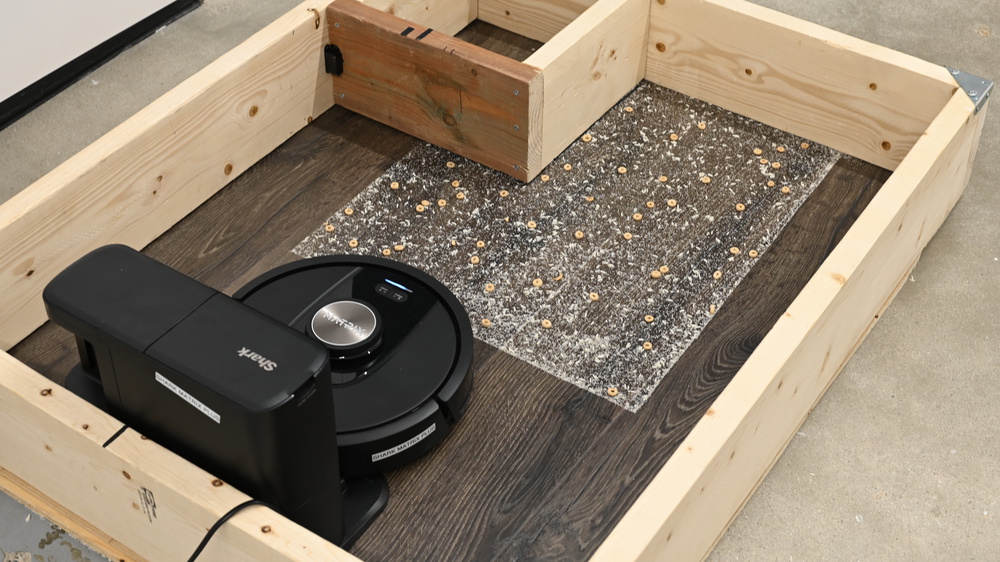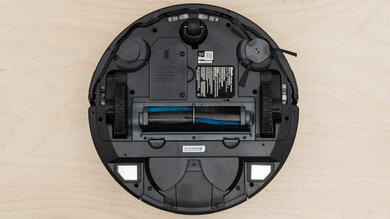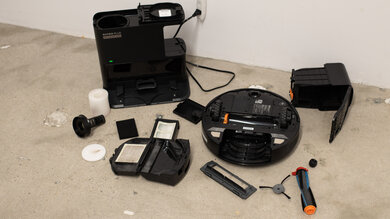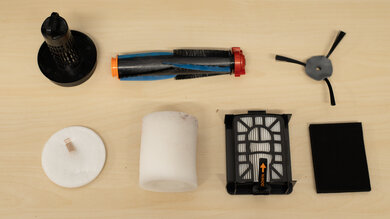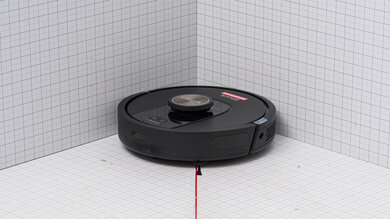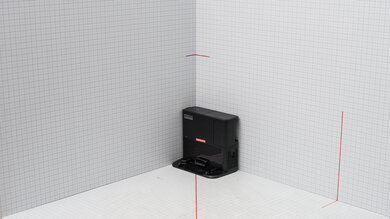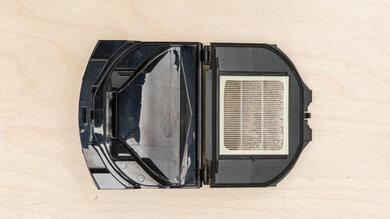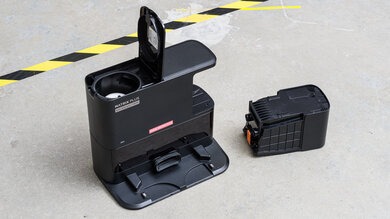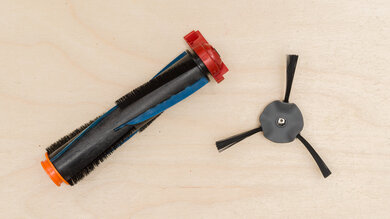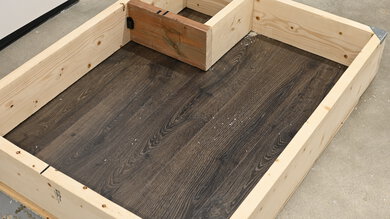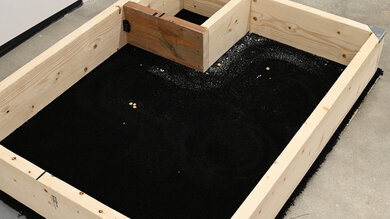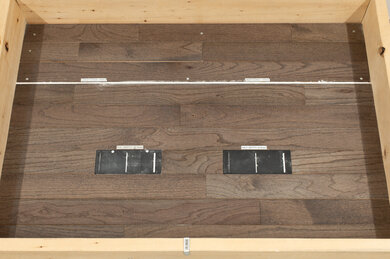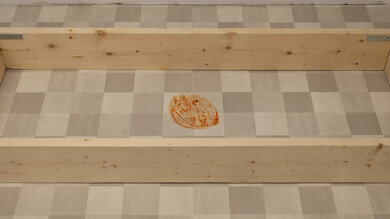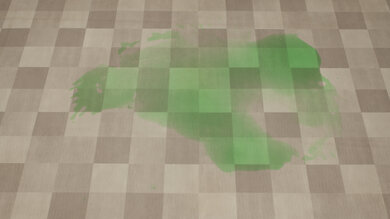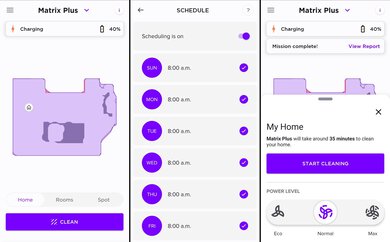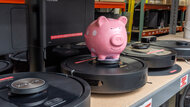The Shark Matrix Plus is a self-emptying robot vacuum sold only through Costco retailers. It's very similar to the standard Shark Matrix Robot but has a dock with a nominally lesser capacity of 30 days' worth of debris compared to the latter's 45-day capacity. Otherwise, it's business as usual for a Shark robovac in this price range: this one features a LIDAR mapping sensor and supports room labeling and virtually-drawn no-go zones, but no in-depth features like room cleaning scheduling or multi-floor mapping functionality. However, it does have a separate Matrix Clean function that allows it to spot clean small areas in a grid pattern.
Our Verdict
The Shark Matrix Plus offers acceptable performance in a household with multiple floor surfaces. It does an excellent job picking up debris on hard floors, but it struggles to lift debris from carpets and is inadequate for cleaning up pet hair, which tends to get tangled in its brushroll. It delivers poor performance in recognizing and adapting to household obstacles. Though it has a self-emptying docking station, its tiny bagless dirt compartment will need to be emptied frequently, which is a dusty, messy process. The robot vacuum also lacks mopping capability.
-
Excellent performance on hard floors.
-
Self-emptying capability.
-
Cleans up medium and large debris on carpet.
-
Struggles with pet hair on carpets.
-
Poor performance with fine material on carpeting.
-
No mopping functionality.
-
Small dirt compartment in docking station.
The Shark Matrix Plus is a poor option for pet owners. It has trouble dealing with pet hair on carpeted floors, and its brushroll is tangle-prone. The vacuum can't recognize or avoid pet waste due to its poor obstacle avoidance system, and can't clean up stains since it lacks mopping capability. The vacuum empties into the docking station, but the docking station's small bagless dirt compartment will fill up with pet hair very quickly, and emptying it may release dust and pet hair. On the upside, the vacuum operates very quietly and won't be overly disruptive, even for pets that are particularly sensitive to loud noises.
-
Quiet operation.
-
Tangle-prone brushroll.
-
Struggles with pet hair on carpets.
-
No mopping functionality.
-
Poor obstacle avoidance.
-
Small dirt compartment in docking station.
The Shark Matrix Plus does an amazing job on hard floors. It picks up almost all material, leaving only a little fine debris in corners.
-
Excellent performance on hard floors.
The Shark Matrix Plus delivers passable performance on carpets. It lacks the agitation to vacuum up fine material embedded in carpet fibers, and does an especially poor job along edges and corners.
-
Cleans up medium and large debris on carpet.
-
Poor performance with fine material on carpeting.
-
Poor performance along edges and in corners.
The Shark Matrix Plus is sub-par at picking up pet hair. Hair gets quickly tangled up in its brushroll and folds the bristles over, causing surface agitation to drop. As a result, the vacuum drags pet hair around and leaves a lot behind.
-
Tangle-prone brushroll.
-
Struggles with pet hair on carpets.
The Shark Matrix Plus is inadequate at handling obstacles. It can clean under some furniture, but can't get under low items, and tends to get stuck on loose rugs. It has a primitive obstacle avoidance system and can't detect small objects, so it runs into just about everything smaller than a pair of shoes.
-
Poor obstacle avoidance.
-
Struggles to clean under low furniture.
- 6.4 Multi-Surface Household
- 4.7 Pets
Performance Usages
- 8.5 Debris Pickup: Hard Floor
- 6.4 Debris Pickup: Carpet
- 5.0 Debris Pickup: Pet Hair
- 4.8 Obstacle Handling
Changelog
-
Updated May 06, 2025:
We've added text to this review for the new tests added in Test Bench 1.0.
- Updated May 02, 2025: We've converted this review to Test Bench 1.0, which updates our performance testing to include new tests to evaluate Obstacle Adaptability, Obstacle Avoidance, Height Clearance, and Threshold Clearance. We've also introduced new performance usages. For more information, see our changelog.
-
Updated Dec 18, 2024:
We've added a link to the Shark PowerDetect RV2820ZE in the Quality-Of-Life Features section of the review to provide an alternative with automatic power adjustment functionality.
- Updated Aug 26, 2024: We've updated the scores in the Hard Floor Pick-Up, High-Pile Carpet Pick-Up, Low-Pile Carpet Pick-Up, and Pet-Hair Pick-Up tests to align with a broader data set. For more information about the reasoning for this update, you can look at our forum post.
- Updated May 24, 2024: Review published.
Check Price
Differences Between Sizes And Variants
The Shark Matrix Plus, otherwise known as the Shark UR2360S, is a robot vacuum sold exclusively through Costco retailers and is only available in a black colorway. See our unit's label.
Let us know if you find another model variant, and we'll update our review.
Compared To Other Robot Vacuums
The Shark Matrix Plus is a self-emptying robot vacuum with a LIDAR sensor. It's an affordable older model, but it lacks convenience features like mopping capabilities or real-time obstacle avoidance found on newer models such as the eufy Omni C20 or eufy E20, respectively. While there aren't many other robot vacuums in this price range with a self-empty dock, one of the few is the Roborock Q5 Max+, which also offers excellent pet hair cleaning performance and is a much better choice than the Shark Matrix Plus for pet owners. Unfortunately, this Shark model doesn't provide the most hands-off user experience on the market either. Its lack of an automatic power adjustment system means you'll need to manually change its suction setting across different floor types, and you can't schedule cleaning sessions for specific rooms in advance, like the Wyze Robot Vacuum.
If you're considering an alternative, look at our list of recommendations for the best robot vacuums for hardwood floors, the best budget robot vacuum cleaners, and the best robot vacuums for carpet.
The Shark Matrix Robot [RV2310AE] and the Shark Matrix Plus [UR2360S] are all but identical robot vacuums, with the latter being a Costco exclusive. While the RV2310AE has a larger self-empty docking station, with an advertised capacity of 45 days of debris compared to the UR2360S' 30-day capacity, we found that both compartments hold a similar amount of debris. It's worth noting that the RV2310AE has a considerably longer battery life.
The Shark AI Ultra Robot and the Shark Matrix Plus are fairly evenly matched robot vacuums with self-empty base stations. The AI Ultra is the slightly older model, with a lower-capacity external dustbin and a battery that takes longer to recharge, though it can run for a lot longer. The Matrix Plus' CleanEdge feature is supposed to provide better performance along walls and in corners, but this feature doesn't seem to make much of a difference.
The iRobot Roomba i8+ and the Shark Matrix Plus are self-emptying robot vacuums exclusive to Costco retailers. Which one is right for you ultimately comes down to your priorities. The iRobot feels like the more premium product, with a much sturdier build, easier maintenance, and a slicker, easier-to-use companion app. It's also the better option if you suffer from allergies; not only does the iRobot do a better job of sealing in allergens as it cleans, but its base station uses a disposable dirtbag instead of the Shark's bagless system, so you won't have to worry about creating a plume of dust when emptying it. Meanwhile, the Shark has a LIDAR sensor that allows for quicker room mapping and slightly less sporadic navigation, even in the dark.
The Shark Matrix Plus is better than the Shark EZ Robot Self-Empty. The Matrix Plus features a LIDAR navigation sensor that allows for quicker, more precise mapping and supports a wider array of automation features, including virtual no-go zones and room labeling. The Matrix Plus' external dustbin also has a slightly greater capacity.
Test Results
The Shark Matrix Plus feels decently well-built. The vacuum body is made mostly from matte-finish plastic, with a few glossy accents and a LIDAR sensor trim piece meant to look like brushed metal. In broad terms, it doesn't feel especially high-end, but there aren't any glaringly obvious weak points in its construction either, aside from the notable exception of its dustbin; when lifting the robot, small debris can spill back out of it due to small gaps in its construction.
On the upside, the vacuum is easy to assemble and set up, with all parts snapping easily into place. Doing things like pulling out the side brush or removing the brushroll is very simple.
The Shark Matrix Plus has many parts that require regular maintenance. Luckily, most are easy to access.
- Dustbin: You can remove the dustbin by simply pressing the two release buttons at the back of the vacuum and then sliding it free. Since the vacuum automatically dumps accumulated debris into the external dirt bin on the charging dock, you'll only need to remove it to clear out blockages.
- Dustbin filter: Since the dustbin filter is built into the dustbin itself, it can be a hassle to clean. After every cleaning session, you should remove any stuck-on debris by hand or with another vacuum.
- Brushroll: You can easily access the brushroll by removing the brushroll cover, which is held in place with simple retention clips. That said, despite being advertised as self-cleaning, the brushroll is somewhat tangle-prone. You can remove any stuck-on debris or tangled hair by hand whenever necessary. It's worth noting that the brushroll on our test unit got stuck during testing, causing the vacuum to send a warning message and refuse to return to its dock until after we cleaned the brushroll.
- Side brush: You can pull the side brush from its socket. Check for any accumulated debris once a week and clean it as necessary, either by hand or with a dry cloth, as it tends to collect quite a bit of debris.
- Sensors and charging pads: You should dust the sensors and charging pads whenever you notice a buildup of debris.
- Base station dustbin: The external dustbin releases from the base station pretty easily. Another button on the side opens the bottom door so you can dump out any accumulated debris, releasing a cloud of dust and debris. According to the manufacturer, it can hold roughly 30 days' worth of collected debris. Unfortunately, there's no fill sensor, so you'll need to check the dustbin regularly.
- Base station dust bin pre-motor filters: You can lift the base station pre-filters from the top of the dock. You should clean them regularly using only cold water. Let them dry for at least 24 hours before putting them back in their place.
- Base station post-motor HEPA filter: You can find the post-motor filter in the base station behind a filter door on the base station. You should tap it against the side of a trash bin to dislodge any stuck-on debris, but make sure not to clean it under water.
This vacuum incurs high recurring costs, partly due to the added costs associated with its base station.
- Brushroll: The brushroll needs replacing every six to 12 months. No replacement is currently available.
- Side brush: The side brush needs to be replaced when it starts to exhibit visible wear and tear. You can buy a two-pack of replacements here.
- Vacuum pre-motor filter: This filter is built into the vacuum's dustbin and is designed to be reused, not replaced.
- Base station pre-filters: You should swap out the base station's pre-motor filters every six to 12 months. You can buy a set of replacements here.
- Base station post-motor filter: You should swap out the base station's post-motor filter every six to 12 months. You can buy a replacement here.
The Shark Matrix Plus is ultimately fairly compact. Its base station has virtually the same footprint as that of the Shark Matrix Robot, but it stands a little shorter, making it easier to squeeze under some tables.
This vacuum is bundled with a bagless self-empty station. It has a capacity of 1.00L, smaller than many other self-empty stations that use dirtbags with a capacity of 2.00L or more. While this bagless design does cut down on ownership costs since you won't have to purchase new bags regularly, it also means that debris disposal is messier and occurs a little more frequently. As per Shark's advertising material, this station needs emptying every 30 days.
- Shark Matrix Plus Robot
- Robot vacuum body
- Internal dust bin
- Pre-motor filter
- 1x Side brush
- Brushroll
- Brushroll cover
- Quick Start guide
- Base Station
- Self Empty Station/Charging station
- Base station dust bin
- Base station dust bin pre-motor filters (felt and foam)
- Base station dust bin post-motor HEPA filter and cover
- Filter holder
The battery performance is superb. In its high-power 'Max' power mode, it supplies just over an hour of cleaning time. Using its 'Eco' mode doesn't actually extend its battery life by that much, bringing its max battery life to about 100 minutes, which is far less than the otherwise similar Shark Matrix Robot. The vacuum will return to its docking station when its state of charge drops to 15%.
This vacuum has a few quality-of-life features. There are three suction power modes: 'Normal,' which is the default mode; the more energy-efficient 'Eco' mode; and the high-power 'Max' mode. It also offers recharge and resume functionality, allowing it to pick up a cleaning session from where it left off if it needs to return to its base to charge its battery. Beyond that, it has no debris or surface sensors that would allow it to automatically adjust its suction power setting. If that's a must-have feature, the Shark PowerDetect RV2820ZE is a good choice.
Debris pickup on bare floors is excellent. It clears away the vast majority of larger debris like cereal and medium-sized debris like rice. It can leave behind smaller pulverized chunks of both and fine debris like sand. Having the vacuum make another pass would likely solve this.
It's worth noting that this vacuum did struggle with navigating within the confines of its test box when its dock station isn't accessible, as seen here. However, this is unlikely to present a problem in real-world use since the dock is always likely to be accessible.
The Shark Matrix Plus delivers decent performance on high-pile carpet. It does an alright job of dealing with medium-sized and large debris on this surface type. That said, it has a much harder time lifting away finer debris like sand that's been worked into this surface type, especially near walls.
Note: We initially encountered some difficulty testing this vacuum on our black sample carpet, as the vacuum's cliff sensors would trigger and cause the vacuum to stop moving. To get around this issue, we covered the sensors with white gaffer tape. This is something to be aware of if you have any black or very dark-colored carpeting in your home.
This vacuum's performance on low-pile carpet is mediocre. It's reasonably good at dealing with medium and large-sized debris but struggles more with finer material, and it has a really hard time collecting debris that's pressed up tight against walls or in corners.
Note: As with testing on high-pile carpet, this vacuum's cliff sensors went off on this surface type, too, causing the vacuum to stop moving. Once again, covering the cliff sensors with white gaffer tape resolved this issue. This is something to be aware of if you have any black or very dark-colored carpeting in your home.
This vacuum has surprisingly good airflow performance for a robovac, especially in this price range. It's sufficiently powerful enough to lift heavier debris.
This vacuum is remarkably quiet. You'll hear what people nearby say even when the vacuum runs in its most powerful suction mode.
The multifunction dock is noisier than the vacuum when using the self-empty function, with a peak volume of 72.7 dBA.
This vacuum is passable for adapting to typical household cleaning tasks. It cleans the room in a fairly orderly fashion. It handles floor-length mirrors well—it nudges them a bit but won't knock them over. It doesn't get stuck very often and usually manages to free itself to continue cleaning without your intervention.
However, it may miss cleaning under obstacles like tables and chairs due to its inadequate low height clearance and occasionally patchy coverage when its path is interrupted by obstacles. It often struggles with tall, thin obstacles like coat racks and might run into them, get caught in them, or shove them around. It can also suck up loose tasseled rugs, so you should remove these before the robot vacuum starts cleaning.
The Shark Matrix Plus is terrible at avoiding obstacles. It's only equipped with small infrared proximity sensors on the front and right, and can detect obstacles about 4.5" and larger. So, it can't detect or avoid small obstacles like socks, cables, or pet waste. Fortunately, it doesn't often get caught up in these objects, but you can expect it to push them around the room.
This vacuum has disappointing height clearance. It's fairly tall for a robot vacuum, and its high LIDAR sensor will hit low furniture.
This robot vacuum offers decent threshold clearance performance. It lacks specialized hardware to climb tall thresholds, but does a satisfactory job mounting short to moderately tall thresholds.
This vacuum does a poor job of sealing in fine allergens, which can escape from its exhaust and LIDAR sensor port. It's worth noting that the self-empty dock does have a HEPA filter, which should prevent any large clouds of fine dust from spilling out of the dustbin. All the same, if you want a self-empty dock with an extra layer of filtration media, you could check out the iRobot Roomba i8+'s self-empty dock, which uses a disposable dirtbag instead of a bagless system, further minimizing the risk of any mess when emptying it. We don't currently evaluate particle filtration for self-empty docks, so we can't make any definitive statements regarding the Shark dock's performance in this regard.
This vacuum has terrible stain-clearing performance. It has no mopping capability that would allow it to scrub away dried-on stains. If you're looking for a model in Shark's matrix lineup that does have a mopping function, the manufacturer does offer a model with a mopping system, the Shark Matrix Plus 2-in-1. However, we haven't tested this model and can't guarantee it'll perform similarly to the Matrix Plus.
The Shark Matrix Plus has a pretty broad range of automation features. It's capable of self-emptying, which reduces hands-on maintenance requirements. The two control buttons on top of the body allow you to use the vacuum without an internet connection; one sends the vacuum to its dock while the other starts a cleaning session in your home. Holding down the latter button engages the vacuum's 'Matrix Clean' mode, which spot-cleans a small area in a series of tight, overlapping vertical and horizontal grid lines. This mode only works for a small area, and the vacuum won't clean your entire home or even a single room this way. You can see this function in action here.
The SharkClean app is decent overall. You can use it to change the vacuum's suction power mode, command it to clean or return to its dock, schedule cleaning sessions, check the cleaning history and charge status, update the vacuum's firmware, or enable push notifications. After it's mapped out your home, you can also send it to specific rooms or set up virtual boundary lines that you don't want the vacuum to cross. You can see a quick tour of the SharkClean app here. That said, the app is also missing a few nice-to-have features that are becoming increasingly common on some alternatives, like the Roborock Qrevo; there's no multi-floor mapping capability, no obstacles represented in the coverage map, and no floor type sensor. You also can't schedule cleaning sessions for individual rooms or check the real-time position of the vacuum in your home.

